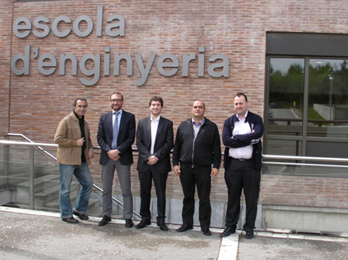PEC4 Cluster aims to strengthen R&D&I in printed electronics

17/05/2012
PEC4 is currently made up of the CETEMMSA technology centre, the National Centre for Microelectronics IMB-CNM (CSIC), the Centre of Environmental Accessibility and Intelligence of Catalonia (CAIAC) and the Metamaterials Research Centre for Innovation in Electronic Technologies and Communications (CIMITEC), both members of the UAB, and the UAB Research Park.
All four centres founded the PEC4 group in 2008 to strengthen the development of research projects in printed electronics. Now they have created the PEC4 Association with the objective of giving this sector a boost and joining together not only research centres, but also other professional bodies in the fields of innovation and knowledge transfer, such as the UAB Research Park, and similar associations such as the SECARTYS electronic industries and the Graphic Communication Industry Association of Catalonia, which is in the preliminary stages of being incorporated into the association.
Members of the PEC4 group cover different aspects of printed electronics and initially focus on the development of printed sensors for biomedical applications, integrated technology solutions for radiofrequency (RFID), luminescent devices in textile, and flexible solar cells used in intelligent environments.
In addition to current members, the PEC4 Association receives the support of ACC1Ó (Catalan Agency for Innovation and Technology Transfer) and participates in the OE-A (Organics Electronics Association) and the COLAE European project (Commercialising Organic and Large Area Electronics).
Revolutionary Technique at Lower Costs
Printed electronics is a new and revolutionary form of electronics. It consists of printing electronic and photonic devices using techniques known to the graphic arts sector, such as serigraphy and inkjet, with the peculiarity that conductor, isolating and semiconductor dyes are used. Developing processes that use these techniques allows printing both electronic components found in conventional circuits and those used in solar panels, batteries, OLEDs (organic light-emitting diode) and plastic or paper-based sensors.
This technique paves the way for new applications such as flexible panels, labels and smart packagings, dynamic decorative signs or upholstery capable of giving off light or becoming a sensor. Another great advantage in manufacturing electronic devices using this technology is the fact that production costs can be noticeably reduced, given that there is no need for a white room, as is the case in microelectronics, and that once the design has been engineered, printing can be done in series using the chosen base, thus reducing manufacturing costs and time. Printed materials are generally very thin, light-weight, flexible and can be easily incorporated into the production line of printed products.
Image: Members of the Board of Directors of the PEC4 Association. From left to right: Lluís Terés from IMB-CNM (CSIC), Carlos Valero from the UAB Research Park; Ferran Soldevila from CETEMMSA, Jordi Carrabina from CAIAC (UAB), and David Marín, General Secretary of PEC4.